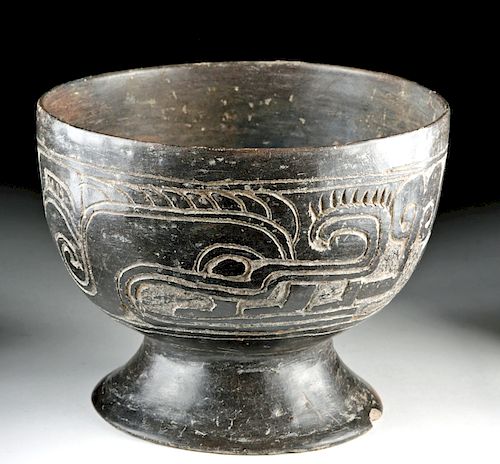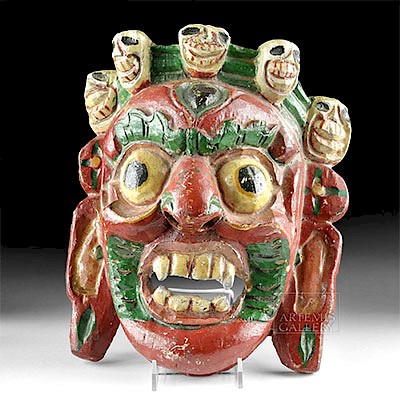Large Olmec / Proto Maya Blackware Chalice
Lot 14h
About Seller
Artemis Fine Arts
686 S Taylor Ave, Ste 106
Louisville, CO 80027
United States
Selling antiquities, ancient and ethnographic art online since 1993, Artemis Gallery specializes in Classical Antiquities (Egyptian, Greek, Roman, Near Eastern), Asian, Pre-Columbian, African / Tribal / Oceanographic art. Our extensive inventory includes pottery, stone, metal, wood, glass and textil...Read more
Estimate:
$2,500 - $3,500
Absentee vs Live bid
Two ways to bid:
- Leave a max absentee bid and the platform will bid on your behalf up to your maximum bid during the live auction.
- Bid live during the auction and your bids will be submitted real-time to the auctioneer.
Bid Increments
| Price | Bid Increment |
|---|---|
| $0 | $25 |
| $300 | $50 |
| $1,000 | $100 |
| $2,000 | $250 |
| $5,000 | $500 |
| $10,000 | $1,000 |
| $20,000 | $2,500 |
| $50,000 | $5,000 |
| $100,000 | $10,000 |
| $200,000 | $20,000 |
About Auction
By Artemis Fine Arts
Apr 25, 2019
Set Reminder
2019-04-25 10:00:00
2019-04-25 10:00:00
America/New_York
Bidsquare
Bidsquare : Pre-Columbian | Tribal | Ethnographic
https://www.bidsquare.com/auctions/artemis-gallery/pre-columbian-tribal-ethnographic-4035
Featuring ancient and ethnographic art from around the world, including Pre-Columbian, Native American, African / Tribal, Ethnographic, Spanish Colonial, Fossils, Fine Art, much more. Artemis Fine Arts info@artemisgallery.com
Featuring ancient and ethnographic art from around the world, including Pre-Columbian, Native American, African / Tribal, Ethnographic, Spanish Colonial, Fossils, Fine Art, much more. Artemis Fine Arts info@artemisgallery.com
- Lot Description
Pre-Columbian, Guatemala and southern Mexico, late Olmec to proto-Maya, ca. 600 to 400 BCE. A handsome, strikingly large blackware vessel, its upper exterior walls decorated with relief images in glyphoid style including the face, in profile, of the feathered serpent, the most powerful god of ancient Mesoamerica. The incised lines that form the images were likely once filled with vibrant red cinnabar pigment. Olmec vessels like this were portable objects that traveled around their area of influence to places like Tlatilco, Tlapacoya, Las Bocas, and San Jose Mogote. Size: 7.45" W x 5.75" H (18.9 cm x 14.6 cm)
The glyphs on this carving are probably epi-Olmec or proto-Mayan. Epi-Olmec, like Mayan, consists of glyphs, often written in lines or columns. Although not all of it has been deciphered, what we know of this language is that it describes religious notions and, to a lesser extent, socio-political matters. It is not clear if glyphs are both pictographic and ideographic, or what role phonograms might have played, and this remains a hotly studied component of Mesoamerican archaeology. With all these questions, can we say anything about this cup? Barring some exceptional circumstances, it was owned by a wealthy person, and buried with them; its glyphs probably speak to the status of the individual or offer a prayer.
Provenance: private California, USA collection
All items legal to buy/sell under U.S. Statute covering cultural patrimony Code 2600, CHAPTER 14, and are guaranteed to be as described or your money back.
A Certificate of Authenticity will accompany all winning bids.
We ship worldwide and handle all shipping in-house for your convenience.
#145730Foot has been repaired from approximately four pieces. Small chip from edge of foot. Otherwise in beautiful condition for its age.Condition
- Shipping Info
-
All shipping is handled in-house for your convenience. Your invoice from Artemis Gallery will include shipping calculation instructions. If in doubt, please inquire BEFORE bidding for estimated shipping costs for individual items.
-
- Buyer's Premium



 EUR
EUR CAD
CAD AUD
AUD GBP
GBP MXN
MXN HKD
HKD CNY
CNY MYR
MYR SEK
SEK SGD
SGD CHF
CHF THB
THB
















